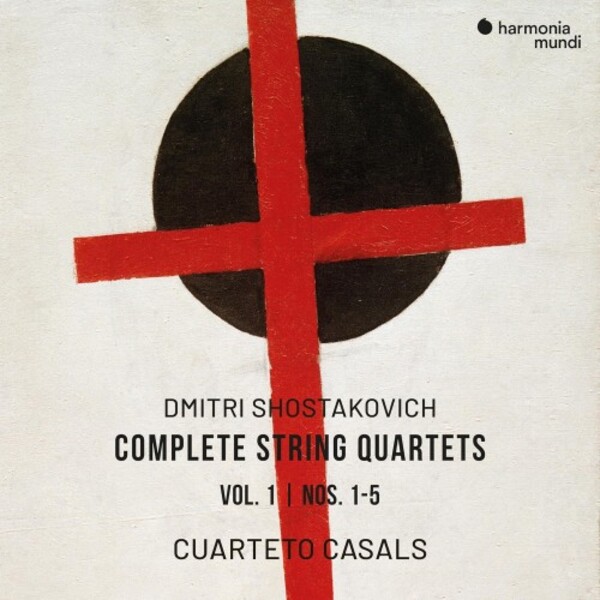SHOSTAKOVICH String Quartets Nos 1-5 (Cuarteto Casals)
View record and artist detailsRecord and Artist Details
Genre:
Chamber
Label: Harmonia Mundi
Magazine Review Date: 01/2025
Media Format: CD or Download
Media Runtime: 140
Mastering:
DDD
Catalogue Number: HMM90 2731-32

Tracks:
| Composition | Artist Credit |
|---|---|
| String Quartet No. 1 |
Dmitri Shostakovich, Composer
Cuarteto Casals |
| String Quartet No. 2 |
Dmitri Shostakovich, Composer
Cuarteto Casals |
| String Quartet No. 4 |
Dmitri Shostakovich, Composer
Cuarteto Casals |
| String Quartet No. 3 |
Dmitri Shostakovich, Composer
Cuarteto Casals |
| String Quartet No. 5 |
Dmitri Shostakovich, Composer
Cuarteto Casals |
Author: Marina Frolova-Walker
While it’s true that Shostakovich’s first five quartets were all written between the Purges and Stalin’s death (from 1938 to 1952), we should resist the temptation to obsess over the circumstances. They are all fine pieces, and deserve to be heard freshly by each new generation. The many lyrical passages, for example, are spoilt if we feel obliged to hear them as bitterly sarcastic. The Spanish Cuarteto Casals seem to have been motivated by such thoughts in presenting their first instalment of the Shostakovich cycle. The result is a far cry from the brittle and acerbic approach taken by the Borodin Quartet (Decca), which was for a long time the benchmark.
Programming the quartets 1, 2, 4, 3, 5 allows, step by step, an increase in intensity from the sweetness of No 1 to the forceful No 5. From the very beginning of No 1, I was seduced by the sound: rich, resonant, expressive and beautifully recorded. But while this relaxed and ingratiating manner allows us to hear hidden virtues in some passages, can it be applied everywhere? I had doubts, as in the second movement, where the marchlike character was softened. But the singing lines, a great attention to polyphony, lovely contrasting timbres, the lightness, the pianissimo and the humour convinced me by the end of the quartet.
No 2 is an enigmatic piece that lends itself to several interpretations. The Fitzwilliam Quartet (Decca, 3/79, 6/92), for example, give the first movement a searing intensity, taking a hint from the surprising violent crescendo marks that make the folksy drone accompaniment sound ill at ease. The Casals Quartet, by contrast, take the folksiness at face value and lend the movement a more joyful character unencumbered by irony. In the Recitative section of the second movement, the evenness of their long, sustained chords is awe-inspiring, but the specifically Jewish character of the cantorial melodic line gives way to some kind of generalised exoticism. When the music settles into a waltz metre, here and in the other quartets on these discs, the Casals’ style dispels all doubts, and their warm lyricism is very welcome. The finale, which is one of Shostakovich’s gradually accelerating movements, takes some time to pick up speed, and it seems as if the players are reluctant to play with a harsher tone or sharpen the rhythms until they are simply forced to do so by the score. Neither at the beginning nor end of the movement is there a sense of weight and significance, because the gorgeous sound lacks bite – it is here that I began to feel that there were real losses as well as gains in the Casals approach.
In No 4, there is an interesting departure from the aesthetic of surface beauty in the crafty altering of the tone of the disturbingly long drone. But after that, the players return to their cultivation of fine detail – attractive at any given moment, but on the large scale, the direction of the movement is submerged. The middle movements lend themselves better to this approach. In the finale, the Jewish elements emerge successfully this time, but the expansive form needs a more consistent urgency to retain its coherence.
Quartets Nos 3 and 5 are among Shostakovich’s most affecting works, at times frightening in their intensity and blistering sarcasm. The Casals Quartet clearly know that a heavier approach is now needed, and, for example, the headlong gallop of No 3’s Scherzo is impressive. But the passacaglia in the following movement needs more intensity at the beginning if the music is not to suffer from ‘longueurs’ (as some of Shostakovich’s detractors put it). No 5 offers many striking and compelling moments, such as the close of the first movement. The intricate polyphonic combinations are finely drawn but the four instruments seem to be accommodating each other rather than colliding – undoubtedly skilful, but not quite Shostakovich’s drama.
The Casals Quartet should certainly be commended for their attempt to rethink the Shostakovich quartets. But their beauty of sound and attention to small-scale detail seems to prevent them from rising to some of the challenges the music poses. The lyrical moments are given their due but the wilder or darker aspects of Shostakovich are domesticated, and the larger dramatic profile can disappear from view. Shostakovich aficionados can benefit from the freshness and fine playing but their prior loyalty to more weighty interpretations is unlikely to be affected.
Discover the world's largest classical music catalogue with Presto Music.

Gramophone Digital Club
- Digital Edition
- Digital Archive
- Reviews Database
- Full website access
From £8.75 / month
Subscribe
Gramophone Full Club
- Print Edition
- Digital Edition
- Digital Archive
- Reviews Database
- Full website access
From £11.00 / month
Subscribe
If you are a library, university or other organisation that would be interested in an institutional subscription to Gramophone please click here for further information.




